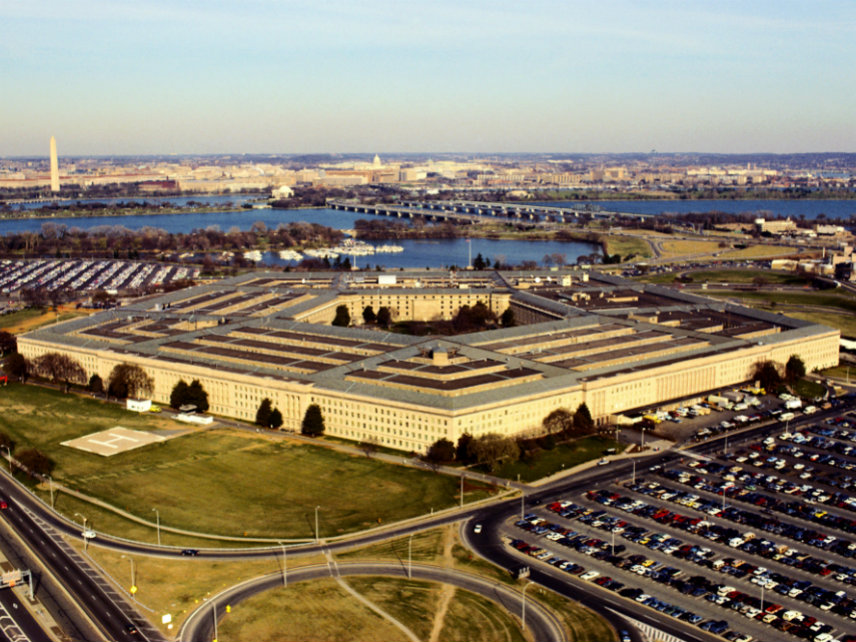U.S. Military Will Cost About $6 Trillion* Over Next Decade, Says CBO
*Not including the cost of ongoing conflicts in Afghanistan, Iraq, Syria, Yemen, Niger...or the $4.8 trillion debt already accumulated from the post-9/11 wars.

American taxpayers will send approximately $6 trillion to the Pentagon over the next decade, as military costs are projected to hit levels 20 percent higher than their Cold War peak, the Congressional Budget Office says in a new analysis.
That doesn't include the cost of so-called "overseas contingency operations," military slang for the billions of spent off-budget every year to fight the never-ending and open-ended War on Terror.
The current federal budget calls for $575 billion to fund the U.S. military, with another $65 billion in OCO costs. The Trump administration's goals for the military—which included a $54 billion boost in Pentagon spending this year—will result in "steady increases" in annual base budgets for the next decade, with non-war-costs hitting $688 billion by 2027, according to the CBO.
Three policies will drive the military budget higher, the CBO analysis says. An increase in the number of military personnel, perhaps by as much as 10 percent (an increase of about 237,000 people). A 30 percent expansion to 355 ships in the Navy fleet. And the cost of weapons (along with research and development, a.k.a. contracts to defense contractors) and military equipment is expected "to outpace inflation."
If the military budget hits $688 billion, as the CBO expects, it would be about 20 percent higher than Pentagon's peak annual spending, adjusted for inflation, during the final stages of the Cold War in the 1980s. The Trump administration's plans to grow the size and cost of the military will cost taxpayers $683 billion more than projections for the next decade made at the end of the Obama administration.
"About half of that difference ($342 billion) would result from implementing the Trump Administration's goals for expanding the size of the military after 2018," CBO analysts write. "The other half of that difference would accrue primarily because more spending is planned for readiness and for research and development than was included in the Obama Administration's final budget plan."
The CBO's estimated $6 trillion price tag for the next decade almost certainly underestimates how much Americans will end up spending to maintain the world's foremost military.
The CBO does not included OCO costs in long-term projections—though the agency says it is now trying to incorporate some elements of those costs in future projections. For now, though, "currently available data are insufficient for CBO to include such estimates," even after 17 years of off-the-books war spending. Since 2001, those OCO costs have totaled "about $2 trillion (in 2018 dollars), or nearly 20 percent of DoD's total funding for the period," CBO says.
There's also other non-Pentagon military spending to consider. Back in 2014, economists at the Mercatus Center identified more than $250 billion in non-Defense Department military spending, which would not be included in the new CBO analysis, either. Other spending included funding for the Department of Veteran's Affairs to care for wounded soldiers and military veterans, Department of Homeland Security spending on counter-terrorism programs, and Department of State funding related to weapons training for foreign militaries and foreign aid, along with increased costs to protect U.S. embassies and consulates in war-torn countries. Additionally, retirement costs for military pensions are not included in the Pentagon's budget.
When tallying up all the spending, it's also good to keep in mind that a lot of it has been put on the federal credit card. As Ron Bailey highlighted earlier this year: The Costs of War Project at the Watson Institute of International and Public Affairs at Brown University calculates that "through 2017, the US federal government has spent or been obligated to spend $4.8 trillion on the post-9/11 wars, including medical and disability payments to veterans over the next 40 years."
"Unless the US changes the way it manages that debt," those researchers note, "future interest will exceed $8 trillion by the 2050s."


Show Comments (29)